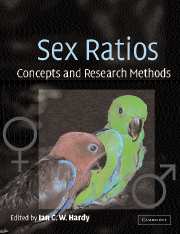Book contents
- Frontmatter
- Contents
- List of contributors
- Preface and acknowledgements
- Part 1 Sex ratio theory
- Part 2 Statistical analysis of sex ratio data
- Part 3 Genetics of sex ratio and sex determination
- Part 4 Animal sex ratios under different life-histories
- Chapter 10 Sex ratios of parasitic Hymenoptera with unusual life-histories
- Chapter 11 Sex ratio control in arrhenotokous and pseudo-arrhenotokous mites
- Chapter 12 Aphid sex ratios
- Chapter 13 Sex ratios in birds and mammals: can the hypotheses be disentangled?
- Chapter 14 Human sex ratios: adaptations and mechanisms, problems and prospects
- Part 5 Sex ratios in plants and protozoa
- Part 6 Applications of sex ratios
- Index
- References
Chapter 13 - Sex ratios in birds and mammals: can the hypotheses be disentangled?
Published online by Cambridge University Press: 06 August 2009
- Frontmatter
- Contents
- List of contributors
- Preface and acknowledgements
- Part 1 Sex ratio theory
- Part 2 Statistical analysis of sex ratio data
- Part 3 Genetics of sex ratio and sex determination
- Part 4 Animal sex ratios under different life-histories
- Chapter 10 Sex ratios of parasitic Hymenoptera with unusual life-histories
- Chapter 11 Sex ratio control in arrhenotokous and pseudo-arrhenotokous mites
- Chapter 12 Aphid sex ratios
- Chapter 13 Sex ratios in birds and mammals: can the hypotheses be disentangled?
- Chapter 14 Human sex ratios: adaptations and mechanisms, problems and prospects
- Part 5 Sex ratios in plants and protozoa
- Part 6 Applications of sex ratios
- Index
- References
Summary
Summary
Birds and mammals are sometimes viewed as black sheep, notorious for their failure to pay attention to the elegance of adaptive sex ratio theory to the same extent as other animals. Here we show that this accusation is unfair. A number of hypotheses contribute to our understanding of why birds and mammals might alter the sex ratio of their young. Most importantly, the long-term studies that have addressed sex ratios have inevitably come to the conclusion that sex allocation is subject to multiple influences. This suggests that where the constraint of Mendelian sex allocation is overcome, a suite of adaptive and nonadaptive influences will combine to affect the sex ratio. As a consequence, predictions of strong bias resulting from the tenets of a single hypothesis are unlikely to be met. Here we review profitable approaches to untangling this complexity.
Introduction
As will be evident from earlier chapters in this book, the study of sex allocation has proved one of the most triumphant areas of evolutionary theory, with explicit theoretical predictions often anticipating parental investment in male and female offspring with great precision. However, comparable progress in understanding sex allocation in birds and mammals has proved much more difficult. Several obstacles have been recognized. First, sex determination is almost ubiquitously associated with chromosome heterogamety, constraining the mechanisms that might be used to alter sex ratios (Williams 1979, 1992).
- Type
- Chapter
- Information
- Sex RatiosConcepts and Research Methods, pp. 266 - 286Publisher: Cambridge University PressPrint publication year: 2002
References
- 172
- Cited by



